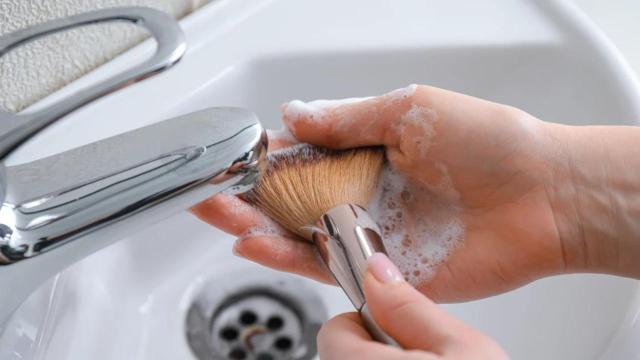Over the years, I’ve accumulated dozens of makeup brushes, which means I’ve also spent far too much time cleaning them. Dirty brushes can screw up your glam, but can also cause breakouts and distribute bacteria and whatever else lurks in your makeup bag across your skin. In worst-case scenarios, you could even get an infection. Cleaning them regularly—every seven to 10 days—is important, but so, too, is doing it right. Some cleaning methods are ineffective and others are downright bad for the brush.
How to clean makeup brushes
There are loads of tutorials all over TikTok, YouTube, and Instagram, showing how influencers and makeup gurus clean their brushes, but a lot of them are full of bad information. For instance, using oil is a no-no; it’s extremely difficult to remove from bristles, which can make the brushes less effective and cause breakouts on certain skin types. Using rubbing alcohol is also a bad idea, as it can weaken the glue that holds the bristles to the handle. also I’ve seen loads of videos where users are fully submerging their brush heads in soapy water. Again, no: Eventually, that can damage the glue, too.
Instead, start with a basic rinse to get the most obvious, external makeup off. Fill a small bowl with micellar water and swirl each brush tip around in there. I love using micellar water to clean makeup brushes because, just as it somehow removes makeup from your skin with ease, it does the same thing here. If you don’t have any, just run the brush tips under a faucet.
Next, refill the bowl with plain, clean water and add a few drops of gentle dish soap or baby shampoo. Avoid using anything else, like hand soap. Some bloggers have recommended Dove body wash in the past, too, but that contains some conditioning agents that can, over time, coat your bristles with a film. The gentler and plainer the soap, the better. Swirl your brush tips in there again, this time massaging them with your hands to “scrub” them. Any time the water gets too dirty, toss it and refill the bowl. Eventually, each brush will stop releasing powders and liquids and, when run back under the faucet, the water coming from them will be clear.
A lot of influencers recommend using a bumpy silicone mat as a scrubber during the cleaning process, but those are specialty products that aren’t really necessary. They’re convenient, yes, but run the spectrum of costliness ($5 for a simple one at Ulta, $35 for the big one on Amazon) and don’t do much more than a good massage with your fingers can do. Their greatest benefit is that, by running your brushes over them, you get a lot of water out, but you can do that yourself by gently squeezing the bristles over your cleaning bowl or sink.
When it’s time to fully dry your bruses, lay them flat on a paper towel, or a microfiber cloth. Don’t splay the bristles out unnaturally to dry them; they’ll dry that way and be difficult to use afterward. Instead, gently shape the bristles back into whatever shape they were before and let them air dry. I usually leave mine at least overnight and come back a few times to flip them over. Do not dry them upright in a container; this will affect the glue on the bristles, as the water will run down. You can even dry them while they hang upside down; if you figure out a way to affix a bunch of handles so the brushes are airborne, you let me know. Drying them flat is perfectly fine, but rotating them periodically so the bristles don’t flatten on one side is a smart move.
How to clean a makeup sponge
Makeup sponges, which had a popularity boom around 2016 but are still a staple in most makeup kits, are much easier to clean than brushes, since you can fully submerge them in water with no problem. You can do it in micellar water first and then switch to your soap-and-water mixture, or just go straight to the soap and water. (A lot of makeup sponge brands sell their own cleanser, but baby shampoo is just as good.)
Submerge the sponge and massage it with your hands, squishing it around until you see makeup start to come out into the water. If it’s really, really dirty, let it sit in that soapy water for 10 minutes or so. Take it out and put some soap directly onto the wet sponge, working it into a lather. Run the sponge under a faucet to rinse it and don’t stop until the water runs clear.
To dry the sponge, prop it up, if you can, and let it air dry. It can air dry flat, but you’ll want to turn it over a few times. Let it dry overnight to make sure there are no wet spots deep inside that could get mildewy. When you think it’s dry, give it a good squeeze to make sure you don’t feel any dampness. Don’t put it back in the drawer or its container until it’s fully dry.

Leave a Reply
You must be logged in to post a comment.